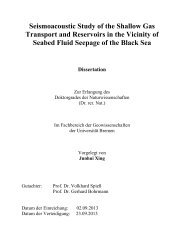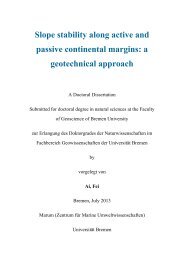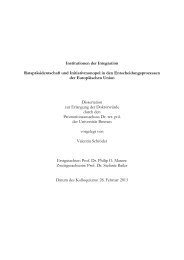Wachstum und Charakterisierung dünner PTCDA-Filme auf ...
Wachstum und Charakterisierung dünner PTCDA-Filme auf ...
Wachstum und Charakterisierung dünner PTCDA-Filme auf ...
Sie wollen auch ein ePaper? Erhöhen Sie die Reichweite Ihrer Titel.
YUMPU macht aus Druck-PDFs automatisch weboptimierte ePaper, die Google liebt.
Abstract<br />
The growth of ordered thin films of organic semiconductors on inorganic semiconductor<br />
surfaces is of great interest owing the to potential for developing hybrid<br />
organic-inorganic heterostructures for novel electronic and optoelectronic device applications.<br />
One f<strong>und</strong>amental aspect is the interaction at the interface of the organic<br />
and inorganic semiconductor which may affect the molecular ordering. The planar<br />
perylene derivative 3,4,9,10-perylene tetracarboxylic dianhydride (<strong>PTCDA</strong>) has been<br />
widely used as a model material in studies of growth of semiconducting organic thin<br />
films. Thus, the growth of <strong>PTCDA</strong> and its interactions with different semiconducting<br />
substrates has been investigated. Due to the fact that dangling bonds at the surface<br />
of inorganic semiconductors strongly affect the molecule-substrate interaction, two<br />
different semiconductor substrate systems were investigated: passivated Si(111) and<br />
unpassivated GaN(0001). As surface passivating agents silver and bismuth were used<br />
resulting in Si(111) √ 3× √ 3 R-30 ◦ -Ag and Si(111) √ 3× √ 3 R-30 ◦ -Bi.<br />
To investigate the growth of <strong>PTCDA</strong> on MOVPE-grown GaN a highly clean semiconductor<br />
surface is required. Therefore cleaning possibilities of GaN(0001) and GaN(2110)<br />
surfaces were investigated. Two different two-step cleaning methods were developed and<br />
compared. Both processes showed an efficient removal of carbon and oxygen species as<br />
quantified by X-ray photoelectron spectroscopy (XPS). Furthermore, scanning tunneling<br />
microscopy (STM) and low-energy electron diffraction (LEED) investigations showed a<br />
drastic improvement of the morphology and atomic structure of the clean surface.<br />
Spot profile analyzing LEED (SPA-LEED) and STM results revealed that <strong>PTCDA</strong> grows<br />
in a bulk-like configuration (herringbone structure) on both passivated and unpassivated<br />
surfaces. Furthermore near-edge X-ray absorption fine-structure (NEXFAS) investigations<br />
were carried out and showed that the molecules are lying flat on both substrates,<br />
which is in good agreement with the observed herringbone structure. On the Si(111)passivated<br />
surface a preferred ordering relative to the substrate lattice has been observed.<br />
In contrast, on the unpassivated GaN(0001) surface rotational domains of arbitrary<br />
azimuthal orientations were identified. The different adsorption behaviour has been explained<br />
by different molecule-substrate interactions. XPS indicates a charge transfer<br />
from the carbonyl oxygen atoms of the anhydride group to the Si(111) √ 3× √ 3 R-30 ◦ -Bi<br />
in the first monolayer while for <strong>PTCDA</strong>/GaN(0001) no strong interactions between the<br />
molecules and the substrate were identified. This distinct interaction also affects the<br />
growth mode of the molecules; a layer-by-layer growth mode was observed for <strong>PTCDA</strong><br />
on Si(111) √ 3 × √ 3 R-30 ◦ -Bi and an island growth mode for the <strong>PTCDA</strong>/GaN(0001)<br />
system.

















